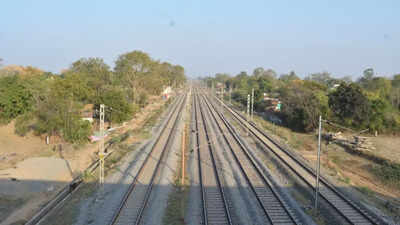- News
- City News
- raipur News
- South East Central Railway expands rail network with key projects in 2024-25
Trending
South East Central Railway expands rail network with key projects in 2024-25
South East Central Railway has significantly expanded its network in FY25, adding 200.15 km of rail lines across key projects like the Anuppur-Katni third line and the Bilaspur-Jharsuguda fourth line. These developments, costing ₹2,896.53 crore, aim to enhance capacity, improve transport efficiency, and boost regional development.
RAIPUR: The South East Central Railway (SECR) has completed several key projects focused on expanding the rail network and strengthening infrastructure in the financial year 2024-25. A total of 200.15 kilometers of railway sections were constructed and commissioned at a total cost of Rs 2,896.53 crore.
Key projects include the Anuppur-Katni third line, which saw 91.52 kilometers of rail lines added. This includes sections between Badwabara–Ghunguti (13.00 km), Ghunguti–Mudaria (10.70 km), Mudaria–Birsinghpur (5.60 km), Umaria–Lorha (10.00 km), Chandia Road–Vilayatkala (9.50 km), Birsinghpur–Nowrozabad (6.90 km), Nowrozabad–Karkeli (10.20 km), and Karkeli–Umaria (12.42 km).
The Rajnandgaon–Nagpur third line project added 63.96 kilometers of rail sections, including Paniajob–Bortalav (8.00 km), Kamptee–Kalamna (7.72 km), Salekasa–Dhanoli (7.00 km), Gudma–Gondia (10.00 km), Gondia–Gangajhari (13.74 km), and ROR Gondia (13.50 km).
Poll
Do you believe that the new rail projects will improve transportation efficiency?
Under the Bilaspur–Jharsuguda fourth line project, 54.57 kilometers of rail sections were constructed, covering Bilaspur–Gatora (8.00 km), Robertson–Bhoopdevpur (9.30 km), Kirorimalnagar–Raigarh (10.27 km), Raigarh–Kotarlia (9.00 km), and Kotarlia–Jamga (8.00 km).
An SECR spokesperson said that these projects will significantly enhance railway capacity and improve the speed, punctuality, and ease of passenger and freight transport.
Improved rail connectivity will also boost regional development and provide alternate routes, reducing congestion and ensuring smooth operations during emergencies.
The projects also align with the goal of promoting sustainable, green railway development.
Following construction, each of these rail lines undergo non-interlocking procedures for integration with their respective stations. This involves yard modifications, track linking, and signaling work. During this phase, passenger trains on affected routes may be temporarily cancelled or rerouted.
Passengers are requested to support the railway administration in these development works, which are essential for future requirements and better facilities.
End of Article
Follow Us On Social Media









